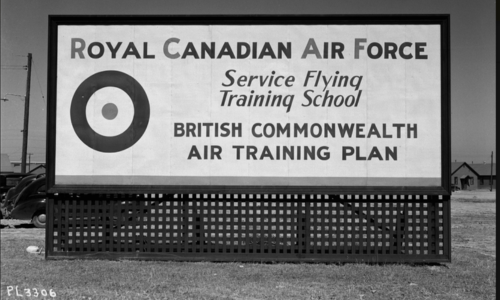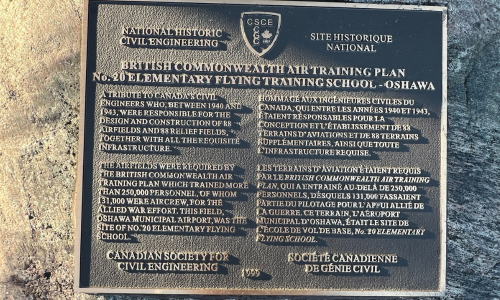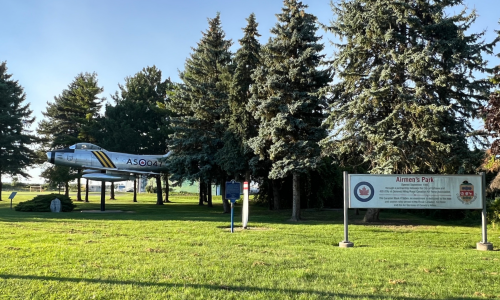Oshawa Executive Airport
The Oshawa Executive Airport is an aviation gateway to the City of Oshawa and the Greater Toronto Area. Located on 484 acres of land, the airport supports corporate business travel and general aviation with:
- a modern terminal building for seamless travel
- dual runways able to service a broad range of aircraft
- modern navigational aids include:
- Area navigation (R.N.A.V.)
- Global Navigation Satellite System
- Lateral navigation (L.N.A.V.)
- Localizer performance with vertical guidance approaches 250 ft. above sea level
- Navigation Canada control tower
- Full Service Fixed Based Operator open 24 hours, 365 days a year
- Various aviation services such as fuel, maintenance and logistical support
- Extensive aircraft storage with over 350,000 sq. ft. of hangar space
The Oshawa Executive Airport is open seven days a week, 365 days a year. However, to minimize noise for residents, flight restrictions are in place to limit operations to police, medical, industrial flights, and Oshawa-based aircraft returning to the airport during certain hours.
Airport Highlights
- The Oshawa Executive Airport maintains a strong commitment to being a good community neighbour with voluntary flight restrictions from 10:30 p.m. to 6:30 a.m.
- Serves as a vital transportation hub for Oshawa and the Durham Region, supporting local business and community growth
- Operated and managed by Total Aviation & Airport Solutions on behalf of the City of Oshawa
- The City has an operating and options agreement in place with the Federal Government, which requires that the City operate the airport until 2047
- The City may close the Airport before 2047 if the Pickering Airport is opened however, the Airport may not close before 2033
- All airport users pay rent, user fees, and other related airport fees consistent with industry practices
- As part of any effort to address the impacts of the additional aircraft traffic on the community, it is critical to understand the legal framework:
- The City cannot unilaterally regulate or control the volume of aircraft traffic from the airport
- The City cannot unilaterally control or regulate the type of aircraft at the airport
- The City cannot unilaterally control or regulate
- The City cannot try to control or regulate the volume of aircraft traffic or the type of aircraft used by indirect means, such as the use of unreasonable fees or unreasonable restrictions including hours of operation, limiting access to taxiways and runways, etc.
Airport History
| Our history |
Early years and wartime beginnings (1941-1944)The Oshawa Executive Airport opened in June 1941 under the British Commonwealth Air Training Plan as No. 20 Elementary Flying Training School, Royal Canadian Flying Clubs Association (R.C.A.F.) Station Oshawa. Civilian instructors from the Oshawa, Kingston, and Brant-Norfolk flying clubs trained student flyers using Tiger Moth aircraft. This school was part of Canada's contribution to the war effort, training approximately 73,000 Canadians during World War II. The school closed in December 1944, and the airfield was handed over to the Department of Transport. The Town of Oshawa took control of the facility in 1947.
Signage for Royal Canadian Air Force Service Flying Training School Post-war transition and municipal management (1945-1947)After World War II, the airport served as a storage base and clearing house for the War Assets Corporation and the Royal Canadian Flying Clubs Association. RCAF closed the airport in the spring of 1945, transferring its operation to the Department of Transport. During this time, the Oshawa branch of the Royal Canadian Flying Clubs Association was formed, and the airport became a hub for civil aviation activities. In 1947, the City of Oshawa officially took over management of the airport.
Canadian Society for Civil Engineering Memorial Plaque, Oshawa Executive Airport Community and commercial evolution (1948-Present)Over the decades, the Oshawa Executive Airport has evolved to meet the changing needs of the community and the aviation industry. As a home to various commercial operations, including aircraft maintenance and restoration services. The airport became a focal point for local aviation enthusiasts, hosting Air Cadet training and community events. The airport's significance grew with the northward spread of suburbs and increased commercial activities, particularly in automobile manufacturing. The airport has continued to thrive as a vital transportation hub.
Pilot’s Air Travel Guide (First Annual Edition – 1978) Oshawa Aerodrome Preserving history and current operationsToday, the Oshawa Executive Airport is divided into the North and South Fields, housing various aviation services including:
The South Field retains its historical significance with original buildings from the 1940s, now home to the Ontario Regiment R.C.A.C. Regimental Museum, which operates popular Tank Saturdays and Tank Ride Programs. Oshawa Executive Airport remains a vital part of Oshawa’s infrastructure, blending historical legacy with modern functionality. Visit Airmen’s Park, featuring a war surplus Sabre aircraft and items commemorating the Airport's past.
1200 Stevenson Rd. N. Airmen's Park Sports Field |
Transport Canada
| The role of Transport Canada |
| Transport Canada is the regulator, and only the Federal government can regulate airport activity. This means that municipal by-laws cannot be used to regulate aircraft activity and that Members of Council, City staff nor the Airport Manager have the authority to regulate aircraft activity and do not have the ability to control or limit flight activities.
The Oshawa Executive Airport is open 24 hours a day, 365 days a year. However, voluntary flight restrictions are in place from 10:30 p.m. to 6:30 a.m., limiting flights to police, medical and industrial flights and Oshawa-based aircraft returning to the airport. Please contact the Federal Minister of Transport if you require further information or clarification on regulating the airport traffic activity. The Federal Minister of Transport, The Honourable Pablo Rodriguez can be reached by To report an aviation incident, please visit the Government of Canada’s website. (note: regulating airport traffic activity and noise abatement procedures may be reported under “Other”). |
Frequently Asked Questions
| What time does the airport close? |
|
The airport is open 24 hours a day, 365 days of the year. However, we have a voluntary policy to limit after hours flights (between 10:30 p.m. and 6:30 a.m.) to police, medical and industrial emergency flights and Oshawa based aircraft returning to the airport. |
| Why are trees being removed and trimmed at and around the airport? |
| The airport conducts surveys to ensure that trees surrounding the airport do not exceed the maximum height permitted by Transport Canada in the Oshawa Airport Zoning Regulations. If a tree becomes a concern, action will be taken to meet Transport Canada's safety regulations and may include tree removal or tree trimming. |
| Does the airport review land use submissions and planning decisions? |
| The airport reviews all land use submissions and site plans submitted to the City of Oshawa and most submissions from the eastern side of the Town of Whitby. It is essential to ensure that all land use and planning decisions comply with Transport Canada Airport Zoning Regulations as they set the obstacle height, the attraction of wildlife, and the airport noise exposure forecast (N.E.F.). |
| What determines which runway aircraft use? |
|
Transport Canada requires aircraft to take-off and land facing the wind for safety reasons.
|
| Why are military jets flying over Oshawa? |
| Military aircraft may conduct training exercises or search and rescue missions along Lake Ontario. They often stop at the airport to refuel their aircraft. However, we do not get advance notice of their arrival most of the time. |
| Do you have any flights to Florida? |
| We do not have any scheduled passenger flights from Oshawa, and there are no plans to have scheduled passenger service. The Oshawa Executive Airport is Ontario's largest general aviation and corporate only airport serving Oshawa, Durham Region, and the Greater Toronto Area. |
| Can I book a scenic flight for my family? |
Two businesses at the airport offer introductory and scenic aircraft flights.
|
| I have an unmanned aerial vehicle. Where am I allowed to fly? |
| Visit the Transport Canada website for information about the operation of unmanned aerial vehicles or drones. |
| How can I obtain a temporary crane permit? |
|
Obstacles in the airspace around the Oshawa Executive Airport, such as temporary cranes, are a hazard to aviation safety. Therefore, it is essential to inform pilots of the locations of these obstacles and the time and date they will be in the airspace. In addition, there are limitations to the height of these temporary obstacles under the Oshawa Executive Airport Zoning Regulations. These heights vary depending on your location. In some cases, temporary exemptions may be granted to these limitations; however, this process can take up to 60 days to complete. Complete a Temporary Crane Permit Application now Processing Times: The Oshawa Executive Airport will make every effort to process the permit application for cranes below the airport zoning limitations within three business days. If you are eligible and require an exemption to the zoning, processing your request may take up to 60 business days. Electronic submissions may also decrease the time needed to assess a submission. For more information, please email [email protected] |
| Why do they aircraft always seem to fly over my house regardless of which way the wind is blowing? |
| Nav Canada operates the control tower at the Oshawa Executive Airport and is responsible for the arrival and departure of all aircraft between 6:30 a.m. and 10:30 p.m. daily. This includes selecting which runway to use based on Transport Canada regulations. When the winds are 5 knots or above, based on the control tower’s wind monitoring equipment, these regulations mandate that the control tower staff must direct aircraft to the most favorable runway based on the wind direction with the exception that larger aircraft may request the airport’s main runway 12/30 due to its longer runway length. |
| What are the roles of Transport Canada and NavCan? |
|
Transport Canada is the regulator and they are responsible for establishing and ensuring compliance with all regulations governing airport operations, aircraft operations and the operation of the air navigation system. It is important to note that only Transport Canada can establish and enforce regulations relating to aviation such as the aircraft noise abatement regulations. Nav Canada is a not-for-profit corporation responsible for the operation of Canada’s national air navigation system, including the operation of the Nav Canada control tower located at the Oshawa Executive Airport. In its control tower, Nav Canada is responsible for the arrival and departure of all aircraft using the Oshawa Executive Airport. This includes the selection of which runway to use in accordance with Transport Canada regulations; Nav Canada operates the tower (including runway selection) between 6:30 a.m. and 10:30 p.m., 365 days a year. |
| Why does flight training occur on some holiday Mondays such as Family Day or Easter Monday when the voluntary noise abatement procedures indicate that there should not be any circuit training on the Sunday and Monday of long weekends? |
| The airport is regulated by the Federal government and as such this policy applies to all Federal statutory holiday weekends. For example, on the Easter long weekend, Friday is the Federal statutory holiday, and Monday is a Provincial holiday. On this weekend there is no circuit training on the Friday and Sunday. It is important to note that although there is no circuit training on holiday long weekends, aircraft may still depart and return to the airport. |
| What are the annual aircraft movements at the Oshawa Executive Airport? |
| Aircraft movements are tracked using data received from Nav Canada. For further information, visit Statistics Canada’s Aircraft movement webpage. |
| Why are there aircraft movements at night? |
| Night flight aircraft movements are tracked and are limited to police, medical, and industrial flights, as well as Oshawa-based aircraft returning to the airport. |
| What is the status of the Airport Business Plan |
| On June 21, 2021, City Council endorsed the 2021-2022 Oshawa Executive Airport Action Plan outlined in Report DS-21-44. The Oshawa Executive Airport Business Plan is a comprehensive document that guides actions and the decision making process. The Action Plan contains 14 action items related to the Oshawa Executive Airport for the City to advance. Of the 14 action items, six have been addressed, and the outstanding items identified in Report SF-24-24 dated May 8, 2024, will form the 2024 Oshawa Executive Airport Action Plan. On May 27, 2024, City Council endorsed the 2024 Oshawa Executive Airport Action Plan. |
| Will the Oshawa Executive Airport close in the future? |
|
City Council has committed to operate the Airport to not less than 2033, regardless of whether Pickering Airport is built, in order to attract new investment and allow the Airport to fulfill its supporting role as an economic driver of the City and the Region. Under the Operating and Options Agreement with the Federal government, the City has an obligation to operate the airport until 2047 or until the Pickering Airport is built. However, the City may close the airport if it becomes redundant in the future. |
| What are the City’s plans to extend the runway? |
| On June 25, 2012, pursuant to Item DS-12-241, Oshawa City Council passed a resolution not to support any proposed extension of Runway 12/30 from 4,000 ft. to 5,000 ft., and that no further work be done on the runway extension, including further study. Any shift from this position would need direction from Oshawa City Council. |
| What is the City’s arrangement with Total Aviation & Airport Solutions (T.A.A.S.) |
|
The agreement between T.A.A.S. and the City is from September 1, 2016 until August 31, 2026. The annual fee is approximately $990,000. T.A.A.S. provides all the staff and equipment necessary to operate the airport and does not receive a percentage or financial incentive for any fuel sales. |
| Can you sell land at the Oshawa Executive Airport? |
| Any land transaction that involves the sale of City-owned land is governed by the Municipal Act, 2001. The sale of any lands would require Council approval and would only be advanced consistent with the City’s Real Estate By-law, the Municipal Act, 2001 and at fair market value.
Currently, 100% of all land sale proceeds are retained by the City while the airport is operational and are deposited into the airport’s capital reserve account and contribute to the capital needs of the airport. Additionally, the City will not sell or lease new airport lands for flight training purposes. |
| How were the existing landing fees determined as they seem higher than Hamilton, Billy Bishop, Waterloo, Peterborough and Lake Simcoe airports? |
| All airport users pay rent, user fees and other related airport fees consistent with industry practices. A complete review of the airport user fees was undertaken in 2020. This included a review of multiple comparative airport fees along with a comparison of airport revenue generated by each of the three key airport user groups, which are general aviation, flight training and corporate aviation. As a result, the airport fees were amended to provide a better balance between all user groups. |








.png)
